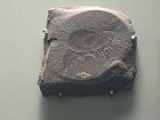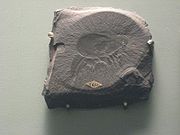
Canadaspis
Encyclopedia

Cambrian
The Cambrian is the first geological period of the Paleozoic Era, lasting from Mya ; it is succeeded by the Ordovician. Its subdivisions, and indeed its base, are somewhat in flux. The period was established by Adam Sedgwick, who named it after Cambria, the Latin name for Wales, where Britain's...
genus
Genus
In biology, a genus is a low-level taxonomic rank used in the biological classification of living and fossil organisms, which is an example of definition by genus and differentia...
of crustacean
Crustacean
Crustaceans form a very large group of arthropods, usually treated as a subphylum, which includes such familiar animals as crabs, lobsters, crayfish, shrimp, krill and barnacles. The 50,000 described species range in size from Stygotantulus stocki at , to the Japanese spider crab with a leg span...
or euarthropod, a benthic feeder that moved mainly by walking and possibly used its biramous appendage
Appendage
In invertebrate biology, an appendage is an external body part, or natural prolongation, that protrudes from an organism's body . It is a general term that covers any of the homologous body parts that may extend from a body segment...
s to stir mud in search of food. The genus has been placed within subclass Phyllocarida
Phyllocarida
Phyllocarida is a subclass of crustaceans, comprising the extant order Leptostraca and the extinct orders Hymenostraca and Archaeostraca....
in class Malacostraca
Malacostraca
Malacostraca is the largest of the six classes of crustaceans, containing over 25,000 extant species, divided among 16 orders. Its members display a greater diversity of body forms than any other class of animals, and include crabs, lobsters, shrimp, krill, woodlice, scuds , mantis shrimp and many...
that includes shrimps and lobsters.
The organism
Canadaspis had claws on the end of its frontal appendages which may have been used to stir up sediment, or to scrape off the top layer, which may have been a nutritious layer of microbesMicrobial mat
A microbial mat is a multi-layered sheet of micro-organisms, mainly bacteria and archaea. Microbial mats grow at interfaces between different types of material, mostly on submerged or moist surfaces but a few survive in deserts. They colonize environments ranging in temperature from –40°C to +120°C...
. Large particles it stirred up would have been captured by spines on the inside of its legs; these spines would have directed the food particles to the organism's mouth, where it used its mandibles
Mandible (arthropod)
thumb|250px|The mandibles of a [[Bull ant]]The mandible of an arthropod is either of a pair of mouthparts used for biting, cutting and holding food. Mandibles are often simply referred to as jaws. Mandibles are present in the extant subphyla Myriapoda , Crustacea and Hexapoda...
to grind larger particles.
Its antennae served a sensory function. Spines on its head probably served to protect its vulnerable eyes from predators. Its limbs probably moved in sequence to produce a rippling motion. Although Canadaspis probably did not swim, this could have helped propel the organism from under soft sediments. The appendages also produced currents which would have helped with feeding and respiration.
Canadaspis is very closely related to the similar organism Perspicaris
Perspicaris
Perspicaris is a fossil arthropod from the Cambrian period. It was long and bivalved. The valves, encasing the thorax, were joined together by a dorsal hinge.It is difficult to establish the lifestyle of Perspicaris...
, differing only in morphological detail.
Classification of Canadaspis
Three alternatives exist for Canadaspiss classification. They concern its relationship to the crustacea; it was originally thought that it falls within that clade, but this no longer appears to be the case. The alternatives are that it is a stem group crustacean, but others believe it is more basal still, falling in the base of the euarthropoda.Fossil occurrences
Canadapsis perfecta, the type species, comes from the Cambrian-age Burgess ShaleBurgess Shale
The Burgess Shale Formation, located in the Canadian Rockies of British Columbia, is one of the world's most celebrated fossil fields, and the best of its kind. It is famous for the exceptional preservation of the soft parts of its fossils...
in British Columbia
British Columbia
British Columbia is the westernmost of Canada's provinces and is known for its natural beauty, as reflected in its Latin motto, Splendor sine occasu . Its name was chosen by Queen Victoria in 1858...
, Canada
Canada
Canada is a North American country consisting of ten provinces and three territories. Located in the northern part of the continent, it extends from the Atlantic Ocean in the east to the Pacific Ocean in the west, and northward into the Arctic Ocean...
. Canadaspis are also found in different formations of the House Range
House Range
The House Range is a north-south trending mountain range in west-central Utah. It is famous for Notch Peak, one of the tallest limestone cliffs in the world, and a fossil Lagerstätte of Cambrian age, which has an array of Burgess Shale type fauna, including Elrathia kingii, a trilobite that is...
of western Utah
Utah
Utah is a state in the Western United States. It was the 45th state to join the Union, on January 4, 1896. Approximately 80% of Utah's 2,763,885 people live along the Wasatch Front, centering on Salt Lake City. This leaves vast expanses of the state nearly uninhabited, making the population the...
as well as the Pioche Shale
Pioche Shale
The Pioche Shale is an Early to Middle Cambrian Burgess shale-type Lagerstätte in Nevada.It spans the Early–Middle Cambrian boundary; fossils from the Early Cambrian are preserved in botryoidal haematite, whereas those from the Middle Cambrian are preserved in the more familiar carbon films, and...
of Nevada
Nevada
Nevada is a state in the western, mountain west, and southwestern regions of the United States. With an area of and a population of about 2.7 million, it is the 7th-largest and 35th-most populous state. Over two-thirds of Nevada's people live in the Las Vegas metropolitan area, which contains its...
. Canadaspis laevigata, coming from the Chengjiang biota and thus some 10 million years older than Canadapsis perfecta, is an equivocal member of the genus. Some scientists believe Canadaspis laevigata to be a more primitive Crustaceomorpha
Crustaceomorpha
Crustaceomorpha is a proposed clade of arthropods that includes the agnostids and the crustaceans. Synapomorphies for the clade are that the larval antenna is a feeding or locomotory organ, and there are six endopodal podomeres in post-antennal limbs....
antecedent of Canadaspis, and others consider it a bi-valved arthropod
Arthropod
An arthropod is an invertebrate animal having an exoskeleton , a segmented body, and jointed appendages. Arthropods are members of the phylum Arthropoda , and include the insects, arachnids, crustaceans, and others...
of uncertain affinity.

